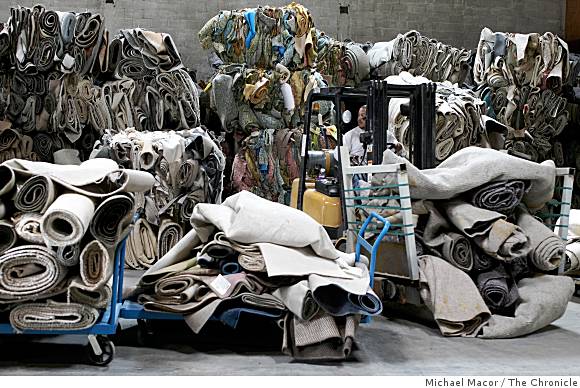
Image Credit: Michael Macor - The Chronicle
Some background on carpet
Most carpet has three primary components: the soft tufted face fiber, the primary backing through which the face fiber is punched, and the secondary backing (the visible back side that locks the face fibers in place). Most residential carpet installations also include a separate cushion or pad.
The face fibers in residential carpet are most often nylon or polyolefin, both thermoplastics, and recyclable. The primary backing in carpet is usually polypropylene (another thermoplastic that can be recycled) and the secondary backing is either a latex material or polyvinyl chloride (PVC). Carpet cushion or pad is usually polyurethane foam, also recyclable. While each of these materials is recyclable individually, it gets tricky when they are mixed or bonded together.
Tearing carpet out
This can be a nasty job and the path to the dumpster almost irresistible. But we toss more than 2.5 million tons of carpet a year in this country and lots of work has been done to make recycling of carpet and carpet pad possible.
In 2002, the carpet industry, key government agencies, and non-profit environmental organizations, created the Carpet America Recovery Effort (CARE). CARE has always had ambitious goals for carpet diversion, starting with 40% by 2012. CARE’s latest report shows a total diversion rate in 2009 of around 25%.
There are currently 72 CARE reclamation partners in the US; you can find the one nearest you using the interactive CARE map. Many CARE locations also take carpet padding. There is also an interactive location tool for carpet and carpet padding recycling at Earth911. If you don’t find any carpet or carpet pad recycling facility within striking distance, talk with your local municipal recycling or solid waste coordinator. It may be possible to work with your town or city on a collection location that then trucks the material to an existing facility.
Recycling costs for carpet and pad are high; while it may be cheaper to recycle than to toss in the landfill, the materials are not high enough in value to mean you will get paid for the material.
Selecting flooring
Now that you have the old carpet torn out, what flooring material do you use to replace it? Wall-to-wall carpet has lots of advantages: it is relatively inexpensive, it’s comfortable to walk (and crawl) on, and it deadens sound fairly well. And many homebuyers like or even expect certain rooms to be carpeted. But carpet is not without its disadvantages: it is not nearly as durable as hard-surface flooring materials, it is difficult or not feasible to repair rather than replace when damaged, and it can harbor quite a number of undesirables, such as dust mites, pet dander, and moisture.
Here are some recommendations for other flooring materials and for greener approaches to carpet.
1. Refinish and rug what you uncover – many hard and softwood floors live underneath wall-to-wall carpeting. Refinishing these floors and using area rugs (which can much more easily be properly cleaned or replaced) is a good combination of durability, comfort, appearance, and indoor air quality.
2. Consider carpet tile – While this approach is much more common in commercial settings, it has a number of advantages. Carpet tiles have a tight durable face fiber and can easily be patched and repaired.
3. Look for greener carpet – Carpet manufacturers are increasingly offering products with recycled content and better air quality profiles. Also look for carpet with the Carpet and Rug Institute (CRI) Green Label.
4. Look for greener carpet pad – There are a wide variety of greener carpet pad materials, including natural materials, such as jute or animal hair, and synthetic materials such as rebond.
5. Mechanically fasten carpet – Carpet can be installed without any adhesives; stick (pardon the word choice) with nailed-down tack strips for installation.
6. Protect carpet from the outdoors – simple things like shoe benches and walk-off mats at entrances to the home and encouraging a no outdoor-shoes policy in your homeowner’s manual can make wall-to-wall carpeting a much better performing flooring.
7. Avoid carpet in high traffic and high moisture areas – Bathrooms, kitchens and basements are tough areas for wall-to-wall carpeting. Other less absorbent sheet goods are a better fit in these areas, but let’s save vinyl flooring for another blog!
Weekly Newsletter
Get building science and energy efficiency advice, plus special offers, in your inbox.















One Comment
Sensitive Issue
Great topic and one that people rarely talk about in the main stream building community. 40% of the US population is sensitive to allergens, which means that 40% of the population would likely be negatively impacted by having carpet in the home. Unfortunately, that number is climbing. Another point worth mentioning is that any home with carpet should use a HEPA vacuum or a substantial amount of dust gets recirculated back into the air when cleaning. Rugs are much easier to clean and retain fewer allergens, which makes them my preference over carpet.
Log in or create an account to post a comment.
Sign up Log in